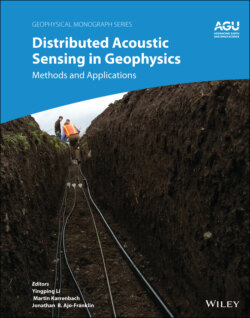Читать книгу Distributed Acoustic Sensing in Geophysics - Группа авторов - Страница 17
1.1.1. DAS Concept
ОглавлениеThe principle of distributed sensing is based on optical time domain reflectometry (OTDR), as indicated in Figure 1.1. When a laser pulse travels down an optical fiber, a tiny portion of the light is naturally scattered through Rayleigh, Raman (Dakin & Culshaw, 1989), and Brillouin (Parker et al., 1998) interactions and returns to the optoelectronic sensor unit. The measurement location can be determined from the time taken for the laser pulse to travel down the sensing fiber, and the backscatter light to return to the optoelectronic sensor unit.
Figure 1.1 shows the basic principle of DAS, where the sensing fiber is excited with a coherent laser pulse and the Rayleigh backscattered interference along the fiber is detected and digitized. An acoustic wave elongates the fiber and so changes the optical phase shift between backscatter components from the leading and trailing parts of the optical pulse. As a result of interference, the intensity of the returning light changes from pulse to pulse. It is also possible to determine the optical phase to recover acoustic phase so there are two classes of DAS, based on the detection of: (i) optical intensity and (ii) optical phase. With the intensity DAS technique, also referred to as coherent optical time domain reflectometry (COTDR), a perturbation along the fiber is detected by measuring the changes in the backscatter intensity from pulse to pulse, as indicated in Figure 1.2. COTDR has been used for the detection of temperature changes (Rathod et al., 1994; Shatalin et al., 1991) and acoustic vibration (Juškaitis et al., 1992; Posey et al., 2000), along multi‐kilometer fiber cables (Juarez et al., 2005; Shatalin et al., 1998).
The principle of the COTDR system can be understood by analyzing the radiation generated by localized scatter centers (Taylor & Lee, 1993). Here, the coherent scattered light can be represented as the result of two reflections with random amplitude and phase. When the fiber is strained, the backscatter intensity varies in accordance with the strain rate (Figure 1.2), but with an unpredictable amplitude and phase, which changes along the fiber (Shatalin et al., 1998). As a result, the signal cannot be effectively accumulated for multiple seismic pulses: the fiber response to strain is highly nonlinear, and therefore the changes in amplitude and phase cannot be directly matched to the original strain affecting the fiber. The next section discusses ways of addressing this. Therefore, COTDR systems are not that useful for seismic applications.
With the phase DAS technique, the method for optical phase analysis is a key feature of system design. All techniques rely on phase modulation between the beginning and end of a pulse, which can be considered as a double pulse. Such modulation can be performed before or after light propagation over optical fiber, as indicated in Figure 1.3. We have limited our discussion to schemas that have been patented and implemented in practice. In one scheme, which is similar to that used for multiplexed interferometer sensors (Dakin, 1990), two laser pulses with different frequencies may be sent down the fiber (Figure 1.3a). In this case, the acoustic phase shift will be transferred to a frequency difference and can be measured in the photocurrent radio frequency domain.
Figure 1.2 COTDR.
Figure 1.3 DAS schemas: MOD—intensity and frequency modulator; AOM—acousto‐optic modulator.
Figure 1.4 DAS optical setup. Distance is proportional to flytime.
Other solutions, such as that shown in Figure 1.3b, contain an embedded delay line that defines the spatial resolution. We will focus our analysis on this class of systems. Another configuration uses optical heterodyne, as shown in Figure 1.3c, where the backscatter signal is continuously mixed with a slightly frequency shifted local oscillator laser. In this case, the elongation along the fiber is measured by computing the difference of the accumulated optical phase between two sections of fiber, and the measurement is carried out at differential frequency f1 − f2. Although this technique offers a flexible spatial resolution, it requires a laser source with extremely high coherence to achieve reasonable signal‐to‐noise ratio (SNR) performance over several tens of kilometers of fiber. The details of the heterodyne concept are thoroughly covered elsewhere (Hartog, 2017). Another method involves sending multiple pulses of different frequencies, either in series or from pulse to pulse, and then computing the phase of the backscatter signal, as indicated in Figure 1.3d. The phase calculation in this case is similar to first case (Figure 1.3a).
